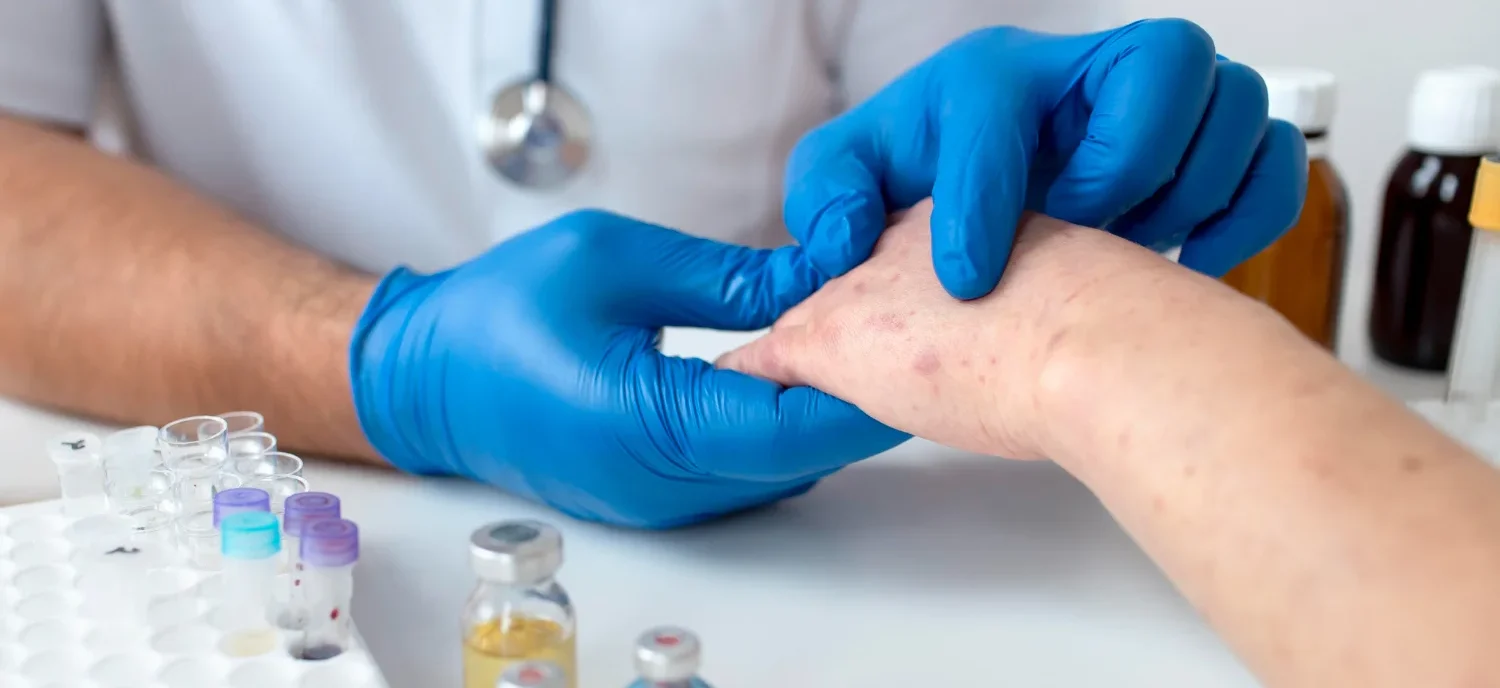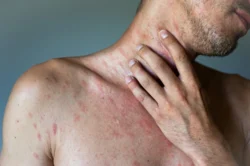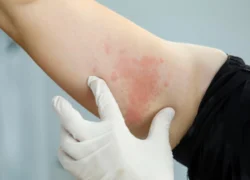
What Are Hives? Causes, Diagnosis, Types & Treatment
Have you ever noticed itchy, red bumps suddenly appear on your skin, only to disappear a few hours later? That might be hives. Also called urticaria, hives are one of the most common skin conditions people experience, but they are also one of the most misunderstood. Many people search for answers to what are hives, especially when symptoms appear out of nowhere and disappear just as quickly.
In this guide, we’ll walk you through everything you need to know about hives in simple terms. Whether you’ve had hives yourself, seen them on someone else, or just want to be prepared, you’ll learn what causes them, how they’re diagnosed, what treatments work, and how to prevent them.
What Are Hives?
Hives are raised, red or skin-colored welts that appear on the skin. They can vary in size and shape and often feel itchy, tingly, or even burn a little. Some welts are small like a mosquito bite, while others can join together into larger patches.
Hives can show up anywhere on your body, including your face, arms, legs, chest, back, hands, feet, and even inside the mouth in rare cases. They can appear suddenly and go away just as quickly, usually within a few hours. However, sometimes they may last longer.
There are two main types:
1. Acute Hives
- Last less than 6 weeks
- Often caused by allergies, infections, medications, insect stings, or food
- Usually resolve on their own or with basic treatment
2. Chronic Hives
- Last more than 6 weeks or come and go over months or years
- Harder to identify a clear cause
- May be linked to the immune system or other health conditions
What Do Hives Look Like?
Some key characteristics of hives include:
- Raised bumps or welts: These can be small or large, circular or irregular.
- Pale center: Some hives have a lighter center surrounded by red edges.
- Blanching: When you press on them, they may turn white temporarily.
- Itchiness: The itching can be mild or very intense.
- Changeable: They might disappear from one area and show up somewhere else.
It’s important to note that hives are not contagious. You can’t catch them from someone else or spread them by touch.

What Causes Hives?
There are many possible triggers for hives. Some are related to allergies, but others are not. Here’s a breakdown of the most common causes:
1. Allergic Reactions
This is one of the most well-known causes. Allergens can cause the immune system to release histamine, a chemical that leads to swelling and itchiness.
Common allergens include:
- Certain foods (nuts, eggs, shellfish, milk)
- Insect stings or bites (bees, wasps, mosquitoes)
- Medications (penicillin, aspirin, ibuprofen)
- Latex
- Animal dander
- Pollen
2. Infections
Viral infections like the common cold, flu, or even COVID-19 can trigger hives in some people, especially children. Bacterial infections and even some parasitic infections may also be culprits.
3. Environmental Triggers
Some people get hives from:
- Sun exposure (solar urticaria)
- Cold weather or cold water (cold urticaria)
- Heat and sweating
- Pressure on the skin (tight clothes, backpack straps)
- Vibration (such as power tools)
4. Stress and Emotional Triggers
Although stress does not directly cause hives, it can make them worse or trigger them in sensitive individuals. Emotional reactions might trigger a release of chemicals that cause hives.
5. Chronic Illnesses and Autoimmune Conditions
In chronic hives, sometimes the immune system gets confused and attacks the body’s own tissues. This can be seen in autoimmune diseases like:
- Lupus
- Rheumatoid arthritis
- Thyroid disorders
6. Idiopathic (Unknown Causes)
Sometimes, even after all possible tests, the exact cause of hives is never found. This is especially common in chronic cases.
How Are Hives Diagnosed?
Doctors usually diagnose hives based on a physical exam and your medical history. There’s no single test for hives, but your doctor may ask:
- When did the hives start?
- What were you doing or eating before they appeared?
- How long do they last?
- Do you have any other symptoms like swelling, trouble breathing, or fever?
- Have you started any new medications or supplements?
If your hives are persistent or severe, your doctor may do tests such as:
- Allergy testing (skin or blood tests)
- Blood work to check for autoimmune or thyroid conditions
- Skin biopsy (rare, usually only in unclear cases)
Are Hives Dangerous?
Most of the time, hives are harmless and just uncomfortable. However, there are cases where they may be a sign of something more serious, especially if they occur with:
- Swelling of the lips, tongue, or throat
- Difficulty breathing or wheezing
- Dizziness or fainting
- Rapid heartbeat
- Nausea or vomiting
These may indicate anaphylaxis, a life-threatening allergic reaction that needs emergency treatment. If you or someone else shows these symptoms, call emergency services right away.

How Are Hives Treated?
Treatment for hives depends on how severe they are, how long they last, and what is causing them. In many cases, hives go away on their own without medical treatment. But if they are frequent, uncomfortable, or severe, you may need medicine or other care.
1. Antihistamines (First-line Treatment)
These are the most common medications used for hives. They block the effects of histamine, the chemical your body releases during an allergic reaction.
Examples include:
- Loratadine (Claritin)
- Cetirizine (Zyrtec)
- Fexofenadine (Allegra)
- Diphenhydramine (Benadryl)
Tip: Non-drowsy antihistamines are often preferred during the day. Drowsy types like Benadryl can help with sleep if itching keeps you awake.
2. Stronger Medications (For Severe or Chronic Cases)
If antihistamines are not enough, your doctor may suggest:
- Corticosteroids (like prednisone) for short-term use
- H2 blockers (used for stomach acid but can help skin symptoms)
- Leukotriene receptor antagonists (like montelukast)
- Omalizumab (a monthly injection for chronic hives)
- Cyclosporine (an immunosuppressant for severe chronic cases)
These are usually used when other options do not work or if the hives are affecting your daily life.
What About Home Remedies?
While medication is helpful, there are also many simple things you can do at home to feel better and stop the itching.
1. Cool Compresses
Applying a cool, damp cloth to your skin can soothe the area and reduce swelling.
2. Oatmeal Baths
Colloidal oatmeal (finely ground oats) in lukewarm water can calm irritated skin and provide relief from itching.
3. Avoid Hot Showers
Heat can make hives worse. Try to use cool or lukewarm water when bathing.
4. Wear Loose Clothing
Tight clothes can rub against the skin and make hives more uncomfortable. Choose soft, breathable fabrics like cotton.
5. Avoid Triggers (if known)
If you know certain things cause your hives, such as a type of food or skincare product, avoid them.
6. Keep a Diary
Write down when hives appear, what you ate, where you were, and what you were doing. This can help you or your doctor find patterns or triggers.
What If Hives Keep Coming Back?
If you have hives for more than 6 weeks, it’s considered chronic urticaria. This type of hives can be frustrating because:
- It may not have a clear cause.
- It can affect sleep, mood, and daily comfort.
- It may require long-term treatment and lifestyle changes.
Managing Chronic Hives
1. Stay Consistent With Medication
People with chronic hives often need daily antihistamines, even when no hives are present, to prevent flare-ups.
2. Reduce Stress
Stress can trigger or worsen chronic hives. Try to find relaxing activities like walking, reading, meditating, or practicing yoga.
3. Diet Review
Sometimes, food additives or preservatives (like artificial colors or sulfites) can be triggers. An elimination diet supervised by a doctor may help.
4. Track Flare Patterns
Keeping a symptom journal may reveal if your hives are linked to weather, menstrual cycles, or certain times of the day.
5. Talk to an Allergist or Dermatologist
Specialists may run more detailed tests or suggest treatments like omalizumab or immunotherapy.
Can Hives Be Prevented?
Sometimes hives can’t be fully prevented, especially when the cause is unknown. But you can take steps to lower your risk or reduce the chances of future flare-ups.
Prevention Tips
- Avoid known allergens: If you know a certain food, medication, or material causes hives, stay away from it and inform your doctor.
- Use gentle skin products: Avoid harsh soaps, detergents, and skincare items with strong fragrances or alcohol.
- Protect your skin: Limit exposure to sun, cold, or pressure on your skin.
- Manage stress: Use stress management techniques regularly, not just during flare-ups.
- Stay cool: Heat can worsen hives, so dress in layers and stay hydrated.
- Consult your doctor before trying new medications: Even over-the-counter drugs can cause allergic reactions in some people.
Are There Long-Term Effects of Hives?
In most cases, hives go away without causing lasting damage. But chronic hives can have emotional and social effects. They may interfere with:
- Sleep: Itching at night can reduce sleep quality.
- Confidence: Visible welts can make people feel self-conscious.
- Work or social life: Frequent flare-ups can limit what people feel comfortable doing.
Support from healthcare professionals, counseling, and joining online communities can make a big difference for those dealing with long-term hives.
When to See a Doctor
While occasional hives may not need medical attention, you should see a doctor if:
- Hives last more than a few days or keep returning
- They don’t respond to over-the-counter medications
- You notice swelling of the face, lips, tongue, or throat
- Breathing becomes difficult or you feel dizzy
- You experience pain or fever with hives
- They interfere with your daily life
Rare and Unusual Types of Hives
While most hives are caused by allergies or irritation, some rare types are linked to physical or internal triggers. Understanding them can help if your hives seem unusual or don’t follow typical patterns.
1. Dermatographism (Skin Writing)
- Light scratching or rubbing causes raised lines or welts on the skin.
- Often harmless and goes away within minutes or hours.
- Affects about 5% of the population.
2. Cold-Induced Urticaria
- Exposure to cold temperatures, wind, or cold water can cause hives.
- Can be dangerous if it affects the airways or occurs after swimming in cold water.
- Usually managed by avoiding cold and using antihistamines.
3. Cholinergic Urticaria
- Triggered by heat, exercise, hot showers, or emotional stress.
- Welts are typically small and can be very itchy.
- May respond to regular antihistamines and cool environments.
4. Solar Urticaria
- Caused by exposure to sunlight or UV rays.
- Affected areas become red and swollen shortly after sun exposure.
- Often requires sun-protective clothing and antihistamines.
5. Pressure Urticaria
- Deep hives appear where the skin is under pressure: tight straps, belts, or standing too long.
- May appear hours after pressure and last longer than typical hives.
- Requires treatment with antihistamines and avoidance of tight clothing or prolonged pressure.
6. Vibratory Urticaria
- Caused by vibration (like from power tools or riding in a bumpy vehicle).
- Very rare and may have a genetic component.
Common Myths About Hives
Hives are often misunderstood. Let’s bust some common myths and clear up confusion.
Myth: Hives are always caused by food.
Truth: While food allergies are a cause, hives can also come from stress, temperature changes, infections, or medications.
Myth: Hives are contagious.
Truth: You cannot catch or spread hives from another person. They’re a reaction from your own immune system.
Myth: You must always find the cause to treat hives.
Truth: Chronic hives often have no known cause. Treatment can still be successful without knowing the exact trigger.
Myth: Only people with allergies get hives.
Truth: Many people with no history of allergies can get hives from infections, pressure, or temperature changes.
Myth: If you don’t see a rash, it’s not hives.
Truth: Some hives are deep in the skin and may cause swelling or discomfort without a visible welt.

Hives vs. Other Skin Conditions
Hives can be confused with other skin issues. Here’s how to tell them apart from some look-alike conditions.
| Condition | Key Features | Difference from Hives |
| Eczema (Atopic Dermatitis) | Dry, scaly patches, often behind knees/elbows | Long-lasting, not sudden or itchy welts |
| Heat Rash | Tiny red bumps, common in babies or hot weather | Not caused by histamine or allergies |
| Bug Bites | Isolated itchy bumps, usually with a bite mark | Don’t move around the body like hives |
| Contact Dermatitis | Red rash from direct contact with irritants (poison ivy, detergent) | Often includes blistering or crusting |
| Psoriasis | Thick, silvery plaques, often on elbows or scalp | Chronic autoimmune condition, not sudden |
| Angioedema | Swelling under the skin, often in lips/eyes | May appear with hives but feels deeper |
If you’re unsure whether your skin reaction is hives or something else, seeing a doctor or dermatologist is the best way to get a correct diagnosis.
FAQs On What Are Hives
Q1: Can hives spread by scratching?
No. Scratching may irritate the skin more and cause new hives to appear nearby, but the condition itself is not contagious or spread by touch.
Q2: Will hives leave scars?
Hives do not typically leave scars. They come and go without damaging the skin, but scratching can lead to broken skin or infection.
Q3: Can children get hives?
Yes. Hives are common in children, especially from viral infections or food allergies. Most childhood cases are mild and temporary.
Q4: Should I avoid exercise if I get hives?
If exercise triggers your hives (as in cholinergic urticaria), talk to your doctor. You may still exercise with precautions, such as using antihistamines beforehand or cooling down quickly after.
Q5: Can hives affect internal organs?
While rare, in severe allergic reactions (anaphylaxis), hives can appear with internal symptoms like low blood pressure or breathing issues. This needs emergency treatment.
Q6: Can hives last for months or years?
Yes. Chronic hives can last months or even years. The cause may remain unknown, but many people find relief with consistent treatment.
Q7: Are there natural remedies for hives?
Oatmeal baths, aloe vera, and cold compresses are popular at-home remedies. However, these do not treat the underlying cause and are best used alongside medical advice.
Conclusion
Hives can be annoying, uncomfortable, and unpredictable, but they are manageable. Whether your hives are short-lived or a long-term issue, the good news is that treatment options are available, and many people find complete relief.
The key is to:
- Identify triggers if possible
- Use antihistamines as needed
- Avoid irritants and allergens
- Seek medical help for frequent, severe, or long-lasting hives
With the right care and knowledge, hives don’t have to take over your life.
